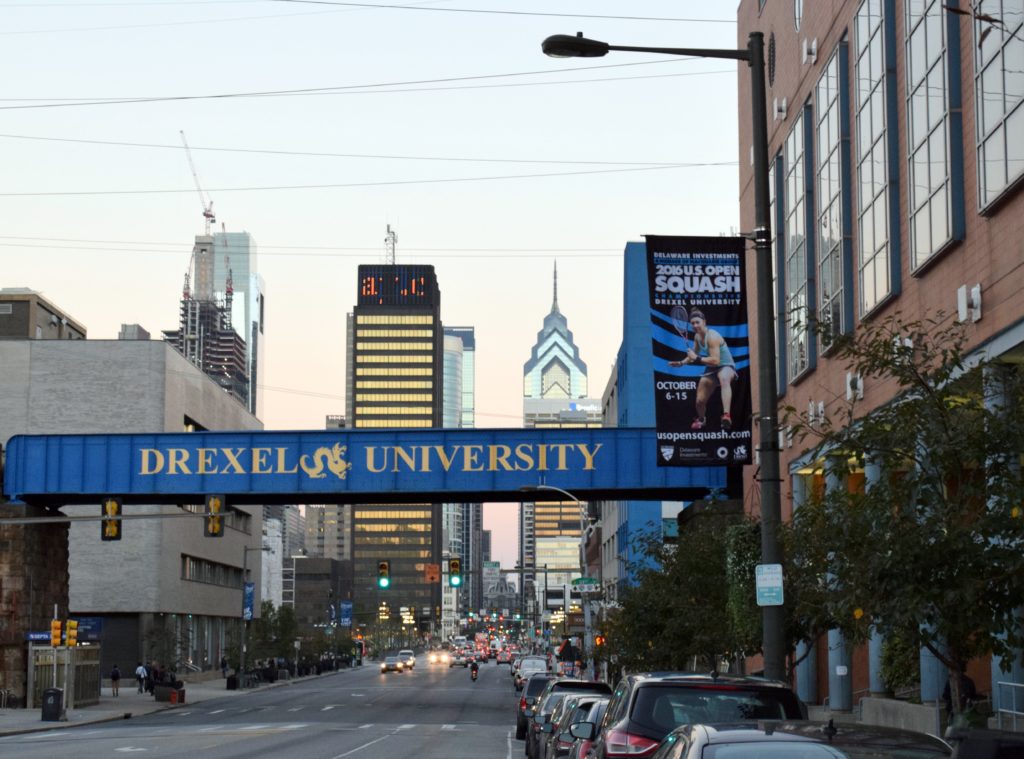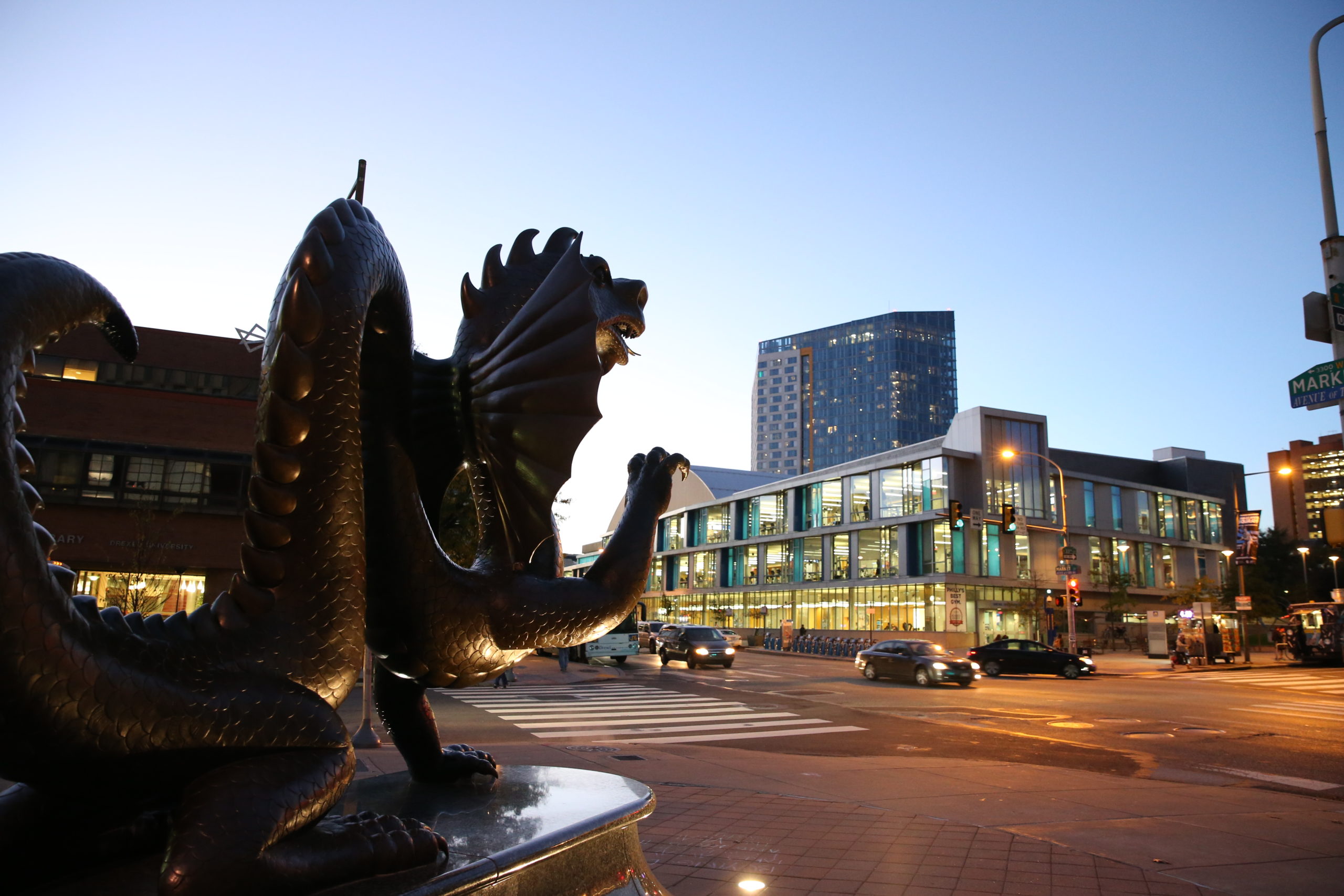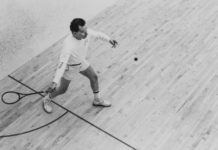The U.S. Open is our national championship but at times the flagship tournament might have felt like an also-ran.
It was founded in 1954 and in its first half century, it moved regularly, visiting a dozen cities around the country, everywhere from a disco in Greenwich Village to Symphony Hall in Boston to Millennium Park in Chicago. It was a peripatetic time for the Open—every few years the tournament would switch venues.
Then in October 2011, the U.S. Open came to Drexel University. Under the leadership of its president John Fry, Drexel offered US Squash the potential of long-term continuity for the U.S. Open and a steadfast partner with whom to grow the event. “Our partnership on the U.S. Open provided an opportunity to bring the most important squash tournament in the nation to Philadelphia, the historic home of the sport,” said Fry. “The U.S. Open gave Drexel a unique platform to showcase all it had to offer to a wide international audience, and also helped to jump-start the success of our fledgling varsity squash teams who have since established themselves as regulars in the top echelon of the college game.”
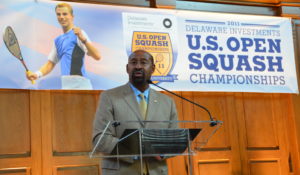 The first year of the hosting agreement required a rapid on-ramp in preparation for the event; the potential for disorganization was high as the small US Squash staff had to coordinate with a large urban university administration. But instead of chaos, all went smoothly as close working relationships developed quickly, fostered on the Drexel side by Eric Zillmer, former Drexel University Director of Athletics, and Laura White, the Associate Head of Athletics. Despite the time crunch, the main basketball arena of Drexel’s Daskalakis Athletic Center (DAC) was transformed into a stunning venue for world-class squash.
The first year of the hosting agreement required a rapid on-ramp in preparation for the event; the potential for disorganization was high as the small US Squash staff had to coordinate with a large urban university administration. But instead of chaos, all went smoothly as close working relationships developed quickly, fostered on the Drexel side by Eric Zillmer, former Drexel University Director of Athletics, and Laura White, the Associate Head of Athletics. Despite the time crunch, the main basketball arena of Drexel’s Daskalakis Athletic Center (DAC) was transformed into a stunning venue for world-class squash.
“We could not have pulled off the success of that first year with any partner other than Drexel,” said Kevin Klipstein, President & CEO of US Squash. “John Fry, the athletic department, and all the university staff and students embraced the event from day one. Since then, our partnership has only strengthened—the U.S. Open is a cornerstone of squash in the country and a leader in event presentation and prize money parity directly because of our enduring partnership with Drexel.”
The excitement was palpable from year one. Drexel’s squash team had just gone to varsity a few weeks earlier and student-athletes on the team had the thrill of watching their new head coach, former world No. 1 John White, compete in the qualifying round (he lost to a young Saurav Ghosal) and later top out at 170mph on a courtside radar gun. Local facilities got involved, hosting qualifying round matches and sending large groups of members to the DAC.
A giant billboard on Market Street trumpeted the Open with the faces of top seeds Nick Matthew and Nicol David, but neither won their draws (nor did the second or third seeds, a first for a U.S. Open). Instead, there was upsets galore. On the men’s side, Amr Shabana came through, winning his first tournament since he had captured the World Championship two years earlier. On the women’s side, Laura Massaro ran rampant, losing just two games en route to her first Open win. Of note were four American teenagers in the women’s qualifying rounds—Olivia Blatchford Clyne, Olivia Fiechter, Amanda Sobhy and Sabrina Sobhy—all of whom a decade later would be in the world’s top twenty-five.
Innovation has been at the forefront of the U.S. Open since Drexel and US Squash first partnered a decade ago. In 2011 the event was the first major to use the new video review referee system, which is now the norm. And the Open offered $175,000 in prize money, the largest purse in U.S. Open history. But the prize money was not divided equally: $115,000 went to the men, $60,000 to the women. That changed in 2013 when US Squash announced full prize money equality—the first major professional squash tournament to offer prize money parity for men and women.
“Any time you can achieve equality in any field of endeavor—be it in sport or in life—everyone wins,” said tennis legend Billie Jean King leading into the 2013 U.S. Open. “This announcement is so much more about the than the money, and I am thrilled another U.S. championship event has stepped up and done the right thing.” In an instant, the U.S. Open transcended its position as a major squash tournament to set a new standard for squash and for women’s equality in sport. In the years to follow, all of squash’s biggest titles embraced parity and soon the women and men’s tours merged, a rare step in professional sports.
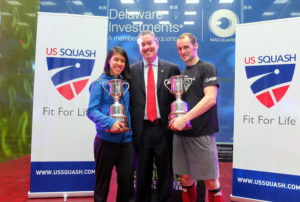 On court, the women drove the point home in 2013 by producing an exceptionally entertaining week of play, which culminated in one of the most gripping U.S. Open finals of all time between Nicol David and Laura Massaro. The first two games went into overtime. Massaro grabbed the third and was up 7-4 in the fourth, just four points from victory, when David stormed back to clinch in five. The match lasted eighty-five minutes, the longest U.S. Open final in a decade. Afterwards, David said that “prize money parity is putting the women’s game where it deserves to be.” The Malaysian lifted a trophy of equal size to Gregory Gaultier’s and took home the same paycheck. As global headlines fixated on prize money parity during finals day, a just-as-transformative story emerged—Drexel and US Squash agreed to extend their partnership to continue hosting the U.S. Open at the university.
On court, the women drove the point home in 2013 by producing an exceptionally entertaining week of play, which culminated in one of the most gripping U.S. Open finals of all time between Nicol David and Laura Massaro. The first two games went into overtime. Massaro grabbed the third and was up 7-4 in the fourth, just four points from victory, when David stormed back to clinch in five. The match lasted eighty-five minutes, the longest U.S. Open final in a decade. Afterwards, David said that “prize money parity is putting the women’s game where it deserves to be.” The Malaysian lifted a trophy of equal size to Gregory Gaultier’s and took home the same paycheck. As global headlines fixated on prize money parity during finals day, a just-as-transformative story emerged—Drexel and US Squash agreed to extend their partnership to continue hosting the U.S. Open at the university.
With steadfast support from Drexel, the U.S. Open expanded its focus to celebrating the entire U.S. squash community. Women in Sports Day reinforced the U.S. Open’s ongoing commitment to gender parity and offered a stage to recognize participants and leaders in the women’s squash community. Character in Sports Day celebrated the shared values of integrity and fair play that link the squash community, as well as those who exemplify those values. The U.S. Open’s professional play was surrounded with amateur competitions, including the Arlen Specter Pennsylvania Junior Championship Tour event and the U.S. Squash Skill Level Championships. In 2015, the U.S. Open welcomed the global community, hosting the World Squash Federation’s Annual General Meeting—the first ever held on U.S. soil. A year later the Squash Summit brought together the best and brightest minds in the squash industry, and was headlined by Lisa Baird, then the Chief Marketing Officer of the U.S. Olympic & Paralympic Committee (Baird recently became the commissioner of National Women’s Soccer League). U.S. Open weeks over the years were packed with awards, meetings, a film festival, panels focused on timely issues in sport featuring squash leaders and Olympians, SquashSmarts students attending clinics with the pros, U.S. Squash Hall of Fame inductions—the tournament was the busiest week of the squash calendar.
With every year, one of the world’s premier squash tournaments became just as much about the community it brought together—from the sport’s luminaries to those who witnessed the sport for the first time in the DAC. It was a home for the U.S. squash community, but for the past several years a new home was being constructed just across 33rd Street in the historic Armory building—the Arlen Specter US Squash Center.
On the 10th anniversary hosting of the U.S. Open in partnership between US Squash and Drexel, the event will now be held at the Specter Center for the first time. Located in the heart of Drexel’s campus just across the street from the DAC, the Specter Center establishes Philadelphia as the permanent home of the U.S. Open.
“You can draw a straight line from the first year of our partnership with Drexel in 2011 to the opening of the Specter Center,” said Ned Edwards, Executive Director of the Specter Center. “Drexel made our use of the stunning Armory building possible, and their support for US Squash and the sport over the past decade created the momentum necessary to build the world’s largest community squash center. The impact of the partnership on the sport is immeasurable, and we’re deeply grateful for their commitment to us and for the impact it will allow us to make in the neighborhood and nationwide.”
